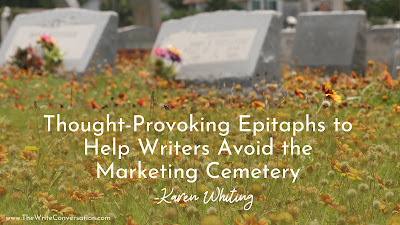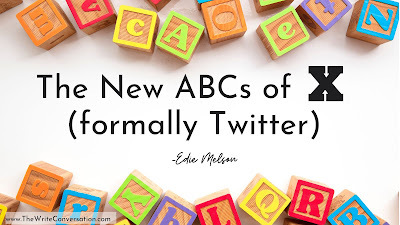Edie Melson's Blog, page 42
August 20, 2024
3 Ways to Avoid Writing a Boring Bible Study

by Katy Kauffman @KatyKauffman28
I was shopping so much on Amazon one fall, that I thought about putting a sign with some cookies next to the pumpkins on my porch. The sign would greet every Amazon delivery driver with “Thank you for your visit,” so they wouldn’t get tired of coming. I don’t shop like the main character in Confessions of a Shopaholic which features Isla Fisher’s character, Rebecca, as an obsessed shopper, but she did say something that stuck with me.
Known for being quite candid, Rebecca told a banker that his bank had “the most boring window display.” She went on to say, “It’s like someone hit the snooze button in my brain.” When people read the Bible studies we write, we don’t want them to hit any snooze button or even think about snoozing.
So how can we write Bible studies that are far from boring?
3 Ways to Avoid Inspiring Your Readers to Hit the “Snooze Button"
1. Write from an angle that appeals to your readers—make it interesting.
In Confessions of a Shopaholic, Rebecca was a journalist who was given an assignment to write about a topic from an angle. Writing “head-on” wasn’t enough. A direct approach in Bible study writing may be accurate, but it can also turn out factual and not warm or interesting enough.
Think about your topic and your target audience. What story or metaphor would introduce the topic, Scripture, or principle you want to write about? In the preface to my first book, I talked about baking (and eating) brownies, and my friends never forgot it. In the second compilation I put together, we used house renovation to talk about how God renovates our hearts to be like His Son’s.
2. Give the “juicy’s” when you explain Scripture—make it meaningful.
I’m sorry but I just can’t take burgers baked in the oven anymore. I’ve tried. I need a grill. When you have the choice of eating a juicy burger with melted cheese on top versus a dry one that needs more cheese than is healthy, which would you choose?
Scripture is alive and powerful on its own, but it matters how we present it. Do we take enough time to prepare the messages in our writing so that they are appealing? Do we look at the definitions, cross-references, and commentary notes we have gathered about a passage, and share what best supports our point? And do we word it in a way that is “juicy” and meaningful, not dry and bland?
One of the best ways to explain the Bible is to look at what Scripture itself uses to make a point. In Mark Chapter 5, a contrast caught my attention in how people responded to Jesus. After He freed a man possessed by a legion of demons, He allowed the demons to enter a herd of pigs who ran down a cliff into the sea. The pig herders told everyone in town what happened, and when the townspeople came out, they saw the formerly demon-possessed man “sitting and clothed and in his right mind” (Mark 5:15 NKJV). You would think that would be a good thing.
Instead of joy, the people felt fear and begged Jesus to leave; instead of fear, the freed man felt joy and begged Jesus to let him follow Him. In our lives today, hopelessness can dwell in us like a legion of sorrows. Sometimes we feel trapped in our own minds by negativity and despair. But Jesus has the power to free us. No matter how bad it gets, Jesus can help us.1
When we explain Scripture, we can use the best tools and notes we find to showcase the beauty, hope, and help found in God’s Word.
3. Work with God to create application that “sticks” in their hearts and minds—make it relevant.
What is application that “sticks”? It’s appealing, meaningful, and relevant to the reader. It has enough “weight” that it’s sound (based on accurate interpretation) and substantive (not too “surface level”). It costs us something to write it (enough study time, prayer time, and life experience), and it costs them something to live it out (understanding God’s Word, accepting His promptings, and practicing what His Word teaches).
Can you name some Bible study writers, besides yourself, whose application has stuck in your mind and heart? How does that “sticking” happen? For me, I had a need. The author showed how God and His Word meet that need, how to trust Him and what next step to take, and the blessing that comes with following Him. That’s the what, the how, and the why—the what of God’s truth, how to live it out, and why it’s important. Sharing a combination of at least two of these, can help our application to stick in our readers’ minds.
When you read someone else’s Bible study, which of the numbered points above that they have accomplished, “stick” with you the most? Tell us in the comments section.
Then think about this—which of these do you tend to focus on when you write, and which one might need a little more attention in the future? God bless you as you write for Him!
1Portions of this paragraph come from my article, “No Matter How Bad It Gets,” in Feed Your Soul with the Word of God, Collection 2 (Buford, Georgia: Lighthouse Bible Studies, 2023), 93.
TWEETABLE3 Ways to Avoid Writing a Boring Bible Study from @KatyKauffman28 on @EdieMelson (Click to Tweet)
 Katy Kauffman is an award-winning author, an editor of Refresh Bible Study Magazine, and a co-founder of LIGHTHOUSE BIBLE STUDIES. She loves connecting with writers and working alongside them in compilations such as For Love’s Sake: The Life-Changing Facets of Love in 30 Bible Studies, Devotions, and Christian Living Articles, which was a 2023 finalist in the Director’s Choice Awards. She also enjoys encouraging writers and giving writing tips in her writers’ newsletter called THE LIGHTHOUSE CONNECTION.
Katy Kauffman is an award-winning author, an editor of Refresh Bible Study Magazine, and a co-founder of LIGHTHOUSE BIBLE STUDIES. She loves connecting with writers and working alongside them in compilations such as For Love’s Sake: The Life-Changing Facets of Love in 30 Bible Studies, Devotions, and Christian Living Articles, which was a 2023 finalist in the Director’s Choice Awards. She also enjoys encouraging writers and giving writing tips in her writers’ newsletter called THE LIGHTHOUSE CONNECTION.In addition to online magazines, Katy’s writing can be found at CBN.COM, thoughts-about-God.com, and three blogs on writing. She loves to spend time with family and friends, create art and make crafts with her group MY ARTSY TRIBE, and tend the garden in the morning sun. She makes her home in a cozy suburb of Atlanta, Georgia. Connect with her on FACEBOOK and TWITTER.
Published on August 20, 2024 22:00
August 19, 2024
Five Ways to Stay Relevant as an Author

by Katherine Hutchinson-Hayes @KHutch0767
I remember getting my first Walkman as a teen. My world was transformed as I jammed out to cassette tapes of Prince, Madonna, and Sade. In college, I embraced CDs and upgraded to a CD player. Nowadays, I play music and podcasts through a streaming device. However, I’m sure updated technology will eventually replace this invention. Things change rapidly in technology, impacting everything, including the publishing industry.
As an author, it can be challenging to remain current in a swiftly evolving world. Adapting to the continuous advancements in technology and changing trends is crucial to staying relevant in the dynamic writing environment.
5 Tips for Writers to Stay Connected and Current with Your Audience
1. Accept Change: For writers to remain relevant, they must accept change. It’s critical to keep an open mind and be flexible when utilizing new writing platforms, technology, and writing styles. Adapting to diverse audience preferences can be achieved by experimenting with alternative formats, such as interactive storytelling, podcasts, or video content. Accepting change allows writers to adapt to the demands of the profession.
2. Ongoing Education: We must never stop learning and improving. Utilize conferences, workshops, and online courses to keep up with the most recent developments and industry best practices. We can develop new abilities and maintain our competitiveness in the writing market by making an investment in lifelong learning.
3. Involve Your Audience: Understanding and establishing a connection with our readers is another aspect of staying relevant as a writer. Use online forums, author events, and social media to interact with readers. Pay attention to their choices and feedback so that we may adjust our content to suit their interests. Maintaining a strong and engaged relationship with our audience is essential to our continued relevance and growth.
4. Diversify Your Portfolio: We can remain adaptable and relevant by diversifying our holdings. Investigate writing in many genres, formats, and platforms to broaden our audience and develop our skill set. Expanding our writing portfolio through other genres such as fiction, non-fiction, blogging, or freelance writing can lead to new prospects and maintain the interest and freshness of our work.
5. Remain Current and Informed: Keep up with news from the industry, pop culture, and current events. Knowing what’s happening in the world can help us provide timely and relevant information. To stay current and draw in readers, think about writing about hot topics or providing our viewpoint on pressing problems.
As writers, we need to be flexible, always learning, involved with our audience, have a diverse portfolio, and be current. Through the adoption of these tactics, we can effectively traverse the ever-evolving publishing scene and maintain our influence, regardless of what the future brings.
TWEETABLEFive Ways to Stay Relevant as an Author from @KHutch0767 on @EdieMelson (Click to Tweet)
 Dr. Katherine Hutchinson-Hayes is a review board member and contributor to Inkspirations (an online magazine for Christian writers), and her writing has been published in Guideposts. Her work in art/writing is distinguished by awards, including the New York Mayor’s Contribution to the Arts, Outstanding Resident Artist of Arizona, and the Foundations Awards at the Blue Ridge Mountains Christian Writer’s Conference (2016, 2019, 2021). She is a member of Word Weavers International and serves as an online chapter president and mentor. She belongs to FWA (Florida Writers Association), ACFW (American Christian Fiction Writers), CWoC (Crime Writers of Color),
Dr. Katherine Hutchinson-Hayes is a review board member and contributor to Inkspirations (an online magazine for Christian writers), and her writing has been published in Guideposts. Her work in art/writing is distinguished by awards, including the New York Mayor’s Contribution to the Arts, Outstanding Resident Artist of Arizona, and the Foundations Awards at the Blue Ridge Mountains Christian Writer’s Conference (2016, 2019, 2021). She is a member of Word Weavers International and serves as an online chapter president and mentor. She belongs to FWA (Florida Writers Association), ACFW (American Christian Fiction Writers), CWoC (Crime Writers of Color),AWSA (Advanced Writers and Speakers Association), and AASA (American Association of School Administrators). She serves on the nonprofit organization Submersion 14 board and the 540 Writer’s Community board and is an art instructor for the nonprofit organization Light for the Future. Katherine hosts the podcast Murder, Mystery & Mayhem Laced with Morality. She has authored a Christian Bible study for women and is currently working on the sequel to her first general market thriller novel. Her thriller A Fifth of the Story will debut in February 2024 through Endgame Press.
Katherine flourishes in developmental editing and coaching writers. She has a twenty-year career in education, leadership, and journalism. Katherine freelances as an educational consultant for charter schools, home school programs, and churches. In this role, she has written and edited curriculum, led program development, and helped manage growth facilitating and public relations.
She also works as an editor and book coach through her consulting business. Katherine provides skill, accountability, and professionalism so clients can begin, develop, and finish their writing projects for publication.
Published on August 19, 2024 22:00
August 18, 2024
Thought-Provoking Epitaphs to Help Writers Avoid the Marketing Cemetery

by Karen Whiting @KarenHWhiting
Excuses, good intentions, fear, low confidence, and not following through have consequences, especially in marketing books. Let these humorous epitaphs nudge you to improve your attitudes and strategies.
Here lie the writers that might have been,they attended no classes or conferences.Spent nary a penny for marketing help,needed skills but avoided expenses.
Grumbling and lack of funds are not productive excuses. Check out free tools available plus ways to save and earn money or barter. I started writing as my oldest entered college and my husband had no job. I wrote for my church bulletin and they helped pay for a conference. I found businesspeople who invested frequent flyer miles for me to go. As I learned more, I also found magazine editors, including at conferences, to write for and saved the income to attend the following year. I listed books on marketing on my Christmas list and got them. If you care, you'll find a way.
Piles and piles of unsold booksreveal the great mind of this writer.Without promotion his books just liein some box out of reach of a reader.
You may believe your book is so great that it will sell itself or that God will make sure it sells, but it needs you to get the word out and make the book visible. Remember why you wrote the words and share that passion. Read how hard Paul worked at sharing the message God gave him. He never used hardship as an excuse, but viewed it as a challenge. Realize that God called you and expects you to market the message as Paul modeled.
Here lie what could have been great salesBut authors found marketing a bore.Expecting that editors did that,And wondered why sales didn’t soar.
It's your book so don't leave it orphaned. No one has the same passion for the book as you do. Revisit why you wrote the book and post those reasons. Even if we have a big launch team and a good start, we still need to keep marketing the book. Build on the start with interviews, posts and more to shine a light on the book and why people need it.
Here lie those misguided writerswhose marketing never got strong.With hit or miss efforts, all self-taught,and strategies totally wrong.
We need to learn from those who succeed by taking workshops, reading marketing books, and applying what has worked for other writers. That includes following and implementing the posts in the Write Conversation blog. Follow people whose books sell, especially in your genre, and use ideas taught.
Here lie piles of marketing toolsBookmarks . . . courses . . . webinars too.These writers lost focus and gave up on them,while disciplined writers followed through.
All the knowledge you gain and workshops you take are no help if you don't apply the knowledge and execute a plan to promote the book. Choose what promotion ideas you think will fit your book and motivate your audience to buy. Then write goals, add the steps to your calendar, and do them!
Here lies a writer who lacked discipline.Good intentions are never enough.Hit or miss efforts give half-baked work.Poor marketing efforts produce only fluff.
Just having ideas is not enough. You need a real plan with steps and scheduled times to put them into action. Keep a list of what to do in minutes as well as the big plans that take longer. Get an accountability partner to encourage you to work at the marketing and follow through. Also ask people to pray for your marketing efforts.
Here lie many unknown writerswho lacked good marketing sense.They needed to promote their booksto reach their target audience.
Know your audience and hang out where they gather. That means posting on the social media they use, writing for magazines they read, and listening to their desires and hopes. Respond to those who post or ask questions. Be available to listen and interact. Build relationships so they will become followers.
Here lies a fun-loving author.The jokes in his sales pitch were fun.But they gave no reason to want a book.The people laughed but bought none.
Take marketing seriously and consider how to share the real message of the book that readers need. If you lack creativity to state the message in a few ways seek help from AI (Chatgpt) to give you several slogans or promotional messages. That can expand your vision and marketing direction.
Here lies a wannabe writer of booksin every word she bared her soul Then rejections came and knocked her down,With words unread when she gave up her goal.
It takes persistence. A few well laid plans may fall apart or not work out, but as long as you believe in the book keep promoting it. Try new ways, ask others for ideas, and come up with new plans. My coauthor and I, disappointed by lack of sales from our efforts made new plans and continue to market. We're beginning to see some results. The efforts add up.
Paul arrived in Athens and walked around until he found a new strategy of connecting a statue to an unknown god to the real God. He used every opportunity. Be creative like Paul, and open to new strategies.
Persistence and Application of writing and marketing ideas will pay off!
TWEETABLEThought-Provoking Epitaphs to Help Writers Avoid the Marketing Cemetery from @KarenHWhiting on @EdieMelson (Click to Tweet)
 Karen Whiting (WWW.KARENWHITING.COM) is an international speaker, former television host of Puppets on Parade, certified writing and marketing coach, and award-winning author of twenty-seven books for women, children, and families. Her newest book, The Gift of Bread: Recipes for the Heart and the Table reflects her passion for bread and growing up helping at her grandparent’s restaurant. Check out her newest book Growing a Mother’s Heart: Devotions of Faith, Hope, and Love from Mothers Past, Present, and Future. It's full of heartwarming and teary-eyed stories of moms.
Karen Whiting (WWW.KARENWHITING.COM) is an international speaker, former television host of Puppets on Parade, certified writing and marketing coach, and award-winning author of twenty-seven books for women, children, and families. Her newest book, The Gift of Bread: Recipes for the Heart and the Table reflects her passion for bread and growing up helping at her grandparent’s restaurant. Check out her newest book Growing a Mother’s Heart: Devotions of Faith, Hope, and Love from Mothers Past, Present, and Future. It's full of heartwarming and teary-eyed stories of moms.Karen has a heart to grow tomorrow’s wholesome families today. She has written more than eight hundred articles for more than sixty publications and loves to let creativity splash over the pages of what she writes. She writes for Crosswalk. Connect with Karen on Twitter @KarenHWhiting Pinterest KarenWhiting FB KarenHWhiting.
Published on August 18, 2024 22:00
August 17, 2024
A Writer’s Angst with Auto-Correct

by Tammy Karasek @TickledPinkTam
The many tools a writer might use when crafting their next piece is a long list. While each writer has their preferred ones to use, some may suggest they count on their auto-correct feature no matter which digital item they use. This writer will agree with that thought as it does come in handy when it catches spelling errors and can save me the red face of embarrassment of an improperly spelled word.
Of late, though, I’ve had a love-hate relationship with the auto-correct on my phone. Granted, I’m notorious for typing fast, hitting send, then glancing up to my email or text. Not the best time to proofread something—after it’s sent.
I spoke with a fellow writer and friend recently about how it seems auto-correct has taken on a life of its own for the proper spelling of words. No words in particular, just whatever it decides you should have used there. Yes, I know I could turn that feature off, but in some instances, I’m glad it has caught a misspelled word.
I decided to keep a list for a couple of days to see some of the odd choices good ol’ Auto-Correct has chosen for me. Obviously without permission!
Here’s a few for your reading pleasure:
Typed: No problem, come when you can. Auto Correct thought I meant: O president Blum!
Typed: Go ahead and send your piece for critique.Auto Correct thought I meant: Gone to share peace.
Typed: Sorry, we won’t be there after all. Auto Correct thought I meant: Sorry, you’re not fair after the fall.
Besides the fact that I believe auto-correct doesn’t like me, I have learned a great lesson that I’d better not ignore—the fact I should always proofread everything I write before I hit the cute little blue arrow. On a post recently, I’m so grateful it was someone I knew well and was a female. The three words were changed to a sentence that was extremely embarrassing and one I wouldn’t have said. To anyone. Let’s just say she had a great laugh at my expense and I wanted to hide. For a long while.
After all of this going on this summer, I’ve changed the name of Auto-Correct that more accurately describes how it treats me and my efforts to write quick notes and texts. I call it auto-change-what-I-wrote-to-what-it-thought-I-should-say.
I have vowed to not hit the blue arrow button until I have read what has been typed in the message box.
What about you, do you have issues with auto-correct?
TWEETABLEA Writer’s Angst with Auto-Correct from @TickledPinkTam on @EdieMelson (Click to Tweet)
 Tammy Karasek uses humor and wit to bring joy and hope to every aspect in life. Her past, filled with bullying and criticism from family, drives her passion to encourage and inspire others and give them The Reason to smile. She’s gone from down and defeated to living a “Tickled Pink” life as she believes there’s always a giggle wanting to come out! A writer of Romance—with a splash of sass. She’s also The Launch Team Geek helping authors launch their books and also a Virtual Assistant for several best-selling authors. Don't miss her recent book, LAUNCH THAT BOOK, just released in November.
Tammy Karasek uses humor and wit to bring joy and hope to every aspect in life. Her past, filled with bullying and criticism from family, drives her passion to encourage and inspire others and give them The Reason to smile. She’s gone from down and defeated to living a “Tickled Pink” life as she believes there’s always a giggle wanting to come out! A writer of Romance—with a splash of sass. She’s also The Launch Team Geek helping authors launch their books and also a Virtual Assistant for several best-selling authors. Don't miss her recent book, LAUNCH THAT BOOK, just released in November. Her work was also published in a Divine Moments Compilation Book—Cool-inary Moments. She’s also the Social Media Manager for the Blue Ridge Mountains Christian Writers Conference, Founding President and current Vice-President of ACFW Upstate SC, and Founding President of Word Weavers Upstate SC. She’s a writing team member for The Write Conversation Blog, Novel Academy, MBT Monday Devotions, The Write Editing and more. Connect with Tammy at HTTPS://WWW.TAMMYKARASEK.COM.
Published on August 17, 2024 22:00
August 16, 2024
Tips to Use Titles to Draw People to Your Blog

by Edie Melson @EdieMelson
Beginnings and endings are critical to our success as a blogger. I’ve spent years blogging and learning how to get blog posts found with a topical search. Digital rules are constantly changing. And now, with AI, they have morphed yet again. So today I’m presenting some updated guidelines we need to consider to make sure our readers engage.
TitlesStart with the title of your post. Your title will make or break your post’s visibility. With a good title, the post will rank higher in the search engines. It will have context on social media, and it will give your reader a way to evaluate whether or not the post is relative to them (more specifics about titles in the next chapter).
Yeah, it’s that important. And I spend at least as much time and energy on composing an effective title as I do writing the entire post.
Tips to Come Up with a Good Blog Title
Make sure your post contains a phrase that is something a reader would type into a search engine to find the information within your post. I originally used used the phrase: The Importance of Beginnings and Endings in Blogging. Yes, that’s what that post was about, but that’s not something many people would be searching for and it’s a little niche. So instead I changed the title to Use Titles to Draw People to Your Blog. But even that could be improved upon. Readers love tips and takeaways, so I finally settled on Tips to Use Titles to Draw People to Your Blog. Not very exciting, but super effective. Then I verified this was an effect title by running it through https://www.aminstitute.com/headline/ . I'm looking for a score of at least 40. This title came in at 50.It’s also critical to choose a title that will have relevance if it’s read somewhere other than on your site. For example, suppose the title and link are shared on social media with- out an accompanying image. Does the person reading it have enough context to know what the title pertains to. Here’s what I mean, let’s go back to the original title I was considering, The Importance of Beginnings and Endings. That title is not good because that title has no context. We have no way of knowing whether that refers to life, marriage, blogging or writing a novel. Begin your post with an anecdote or a story. SEO has changed and to set human-written posts apart from AI written posts this is something we can do. After the story, front load the information contained within the post. This is just a fancy way of saying we need to share the takeaway first. In my opening paragraphs I told you what I’d share in this post. Sum up what you’re going to share before you get into the details. Write your post using bold headings, lists and lots of white space. Reading on a mobile device, or even a computer is harder on our eyes than reading a physical magazine or book. That’s why we must format for an audience who uses those mediums. Choose a sans serif font for readability. This means something without those extra flourishes (called serifs). I recommend Ariel, Verdana, or Helvetica. Times New Roman is never a good choice for online readability. This site, The Write Conversation, uses Verdana. Use block formatting. This means no indented paragraphs and an extra blank line between paragraphs. Use shorter sentences and shorter paragraphs. Sentences shouldn’t be over twelve words in length. A block of text (paragraph) shouldn’t exceed six lines. Choose a header image (called a feature image in WordPress) that illustrates the focus of your post. For extra click-throughs on social media, make sure you make it into a meme with the title of your post embedded in the image. Include a Click to Tweet. This is an embedded link that makes it easier for readers to share your post on social media. By including this one feature, your posts will be shared approximately sixty percent more on social media. Wrap it up with a call to action. No, this doesn’t mean you should try to sell them something. Instead, it’s up to you to get the conversational ball rolling. We all want to engage with those who read our posts. And we have to spell out how to do it. So end each post with one of these options: An open-ended question. A yes or no question stops the conversation. Instead use something that leads to discussion or sharing of opinions. A challenge. Sometimes an open- ended question just doesn’t fit (as in some devotions). Instead issue a challenge, maybe something like this: “Today I’ve decided to make a difference by looking for ways to reach out to others, will you join me?” Wrap up everything with a specific set of instructions of what to do. Often I end my posts with something like:“Now it’s your turn ... be sure to share your thoughts in the comments section below.”
All of these tips will help you build an audience that’s loyal, engaged, and willing to share your posts with their friends and family.
TWEETABLETips to Use Titles to Draw People to Your Blog from @EdieMelson (Click to Tweet)
 Edie Melson is a woman of faith with ink-stained fingers observing life through the lens of her camera. No matter whether she’s talking to writers, entrepreneurs, or readers, her first advice is always “Find your voice, live your story.” As an author, blogger, and speaker she’s encouraged and challenged audiences across the country and around the world. Her numerous books reflect her passion to help others develop the strength of their God-given gifts and apply them to their lives.Connect with her on her website, through Facebook, X (formally Twitter) and on Instagram.
Edie Melson is a woman of faith with ink-stained fingers observing life through the lens of her camera. No matter whether she’s talking to writers, entrepreneurs, or readers, her first advice is always “Find your voice, live your story.” As an author, blogger, and speaker she’s encouraged and challenged audiences across the country and around the world. Her numerous books reflect her passion to help others develop the strength of their God-given gifts and apply them to their lives.Connect with her on her website, through Facebook, X (formally Twitter) and on Instagram.
Published on August 16, 2024 22:00
August 15, 2024
Common Sayings from the Bible Many Writers Use

by Crystal Bowman
Whether we are aware of it or not, many of our common sayings and idioms have their origins in Scripture. I’ve gathered a list, but there are many more.
Forbidden fruit – Something desired, but not permitted.Genesis 2:16–7 (NIV) And the Lord God commanded the man, “You are free to eat from any tree in the garden; but you must not eat from the tree of the knowledge of good and evil, for when you eat from it you will certainly die.”
Earn something by the sweat of your brow – To work hard for something.Genesis 3:19 (NIV) “By the sweat of your brow you will eat your food until you return to the ground, since from it you were taken; for dust you are and to dust you will return.”
Apple of my eye – Someone who is deeply cherished.Deuteronomy 32:10 (NIV) “In a desert land he found him, in a barren and howling waste. He shielded him and cared for him; he guarded him as the apple of his eye.”
Nothing but skin and bones – Thin and unhealthy looking. Job 19:20 (NIV) “I am nothing but skin and bones; I have escaped only by the skin of my teeth” (which is also a saying!).
Pride goes before a fall – Having too much pride or confidence can lead to foolish mistakes. Proverbs 16:18 (NIV) Pride goes before destruction, a haughty spirit before a fall.
There’s nothing new under the sun – The monotony of life; everything has been seen, experienced, and done before. Ecclesiastes 1:9 (NIV) “What has been again, what has been done will be done again; there is nothing new under the sun.”
A fly in the ointment – A blemish or small imperfection that affects the quality of the whole. Ecclesiastes 10:1 (NLT) “As dead flies cause even a bottle of perfume to stink, so a little foolishness spoils great wisdom and honor.”
A little birdie told me – A lighthearted phrase to withhold the source of information.Ecclesiastes 10:20 (NIV) “A bird in the sky may carry your words, and a bird on the wing may report what you say.”
A drop in the bucket – Adding something that is insignificant to the whole. Isaiah 40:15 (NLT) “No, for all the nations of the world are but a drop in the bucket. They are nothing more than dust on the scales.”
Rise and shine – A positive call to wake up and start the day.Isaiah 60:1 (NIV) ““Arise, shine, for your light has come, and the glory of the Lord rises upon you.”
Writing is on the wall – Something bad is about to happen.Daniel 5:5 (NLT) “Suddenly, they saw the fingers of a human hand writing on the plaster wall of the king’s palace, near the lampstand. The king himself saw the hand as it wrote.
Go the extra mile – To go above and beyond what is needed or expected. Matthew 5:41 (NIV) “If anyone forces you to go one mile, go with them two miles.”
Out of the mouth of babes – Praise and wisdom from young children Matthew 21:16 (NKJV) And Jesus said to them, “Yes. Have you never read, ‘Out of the mouth of babes and nursing infants You have perfected praise’?” (Jesus is quoting from Psalm 8:2)
Reap what you sow – A warning that our actions carry consequences.Galatians 6:7 (NIV) “Do not be deceived: God cannot be mocked. A man reaps what he sows.”
Did you know these sayings come from the Bible? If the answer is yes—you know the Bible well! What other sayings can you add to the list?
TWEETABLECommon Sayings from the Bible Many Writers Use from author Crystal Bowman on @EdieMelson (Click to Tweet)
 Crystal Bowman is an award-winning, bestselling author of more than 100 books for children and families. She also writes lyrics for children’s piano music and is a monthly contributor to Clubhouse Jr. Magazine, Arise Daily, and Christian Children's Authors. She enjoys coaching children's writers as well as teaching at writers conferences. When she is not writing or speaking, she likes going for walks and spending time with her huggable grandkids. She and her husband live in Michigan and Florida and try to avoid snowstorms.
Crystal Bowman is an award-winning, bestselling author of more than 100 books for children and families. She also writes lyrics for children’s piano music and is a monthly contributor to Clubhouse Jr. Magazine, Arise Daily, and Christian Children's Authors. She enjoys coaching children's writers as well as teaching at writers conferences. When she is not writing or speaking, she likes going for walks and spending time with her huggable grandkids. She and her husband live in Michigan and Florida and try to avoid snowstorms.WWW.CRYSTALBOWMAN.COMWWW.FACEBOOK.COM/CRYSTAL.BOWMANWWW.FACEBOOK.COM/CRYSTALJBOWMANWWW.INSTAGRAM.COM/CRYSTALBOWMANAUTHOR
Published on August 15, 2024 22:00
August 14, 2024
The New ABCs of X (formally Twitter)

by Edie Melson @EdieMelson
Sometimes we tend to overcomplicate social media, especially when there’s a big change. And these days, there’s not a bigger change around than when Twitter became X. Today I'd like to share best practices on this almost-new network.
26 Best Practices for X
1. A is for Accessibility. It’s important to be easy to find on X. This means your X handle STILL needs to be as close to your own name as possible, and your avatar (picture) is recognizable as you.
2. B is for Bio. Even though your bio on X is only 160 characters long, it’s prime real estate. It tells your audience what to expect from your tweets. In it you can—and SHOULD—include hashtags, but don’t make them the only thing you list.
3. C is for Connections. The point of X is still to connect with other people with similar interests. It’s not your private station to broadcast commercials from. Keep self-promotion to a minimum and you’ll find some valuable relationships through this social media platform.
4. D is for Discipline. Small consistent steps will result in a strong X platform. It’s not enough to share updates several days a month. Instead, set a goal for interactions at least 4 times a week. These can be your own tweets, or comments on someone else’s update. It won’t take much time, but it will pay huge dividends in visibility and reach.
5. E is for Evaluate. Evaluate what you’re sharing on X. Is it valuable to your audience or are you just adding to the noise?
6. F is for Focus. Even though I vary the types of updates I share on X, I keep my message (and my X personality) consistent. People who follow me know I post about writing, social media, photography, and spiritual encouragement.
7. G is for Grandmother. I’m convinced my grandmother would have enjoyed social media. It’s a digital neighborhood, with a culture she would have understood. There’s a give and take here, and a willingness to courteous and helpful.
8. H is for Hashtags. Hashtags are one of the best things about X. Do your best to limit yourself to no more than two or three per update. And take time to do a quick search on the search engine of choice for the best hashtag for the topic you’re tweeting about.
9. I is for Irritating. Yes, there are some people on X who are irritating. And if they waste my time, I don’t hesitate to unfollow them. I encourage you to do the same.
10. J is for Jump. Don’t be afraid to jump into the new universe that is X. The easiest way to get started it to dive right in and learn as you go.
11. K is for Keep On. Don’t expect instant results. Like anything worth doing, growing a platform on X takes time (and don’t forget consistency). Don’t get discouraged and DO NOT give up.
12. L is Lists. Learn how to us the LISTS feature on X and gain new followers—who are interested in having true connections—and find others who share your same thoughts and opinions.
13. M is for Myself. It’s critical that we're honest and genuine on social media. We don’t have to over-share but we do need to be authentic.
14. N is for Notifications. Notifications are a GREAT way to get noticed on X. First, find the influencers in the topics you want to become known for. Once you’ve identified them, set notifications so you know when these influencers are posting. Finally, try to be one of the first to comment. This will get you noticed and open opportunities to grow your reach.
15. O is for having an Open-Door Policy. Make yourself accessible and visible on X. The point of being on X is to be found. If you don’t want to be found, stay off social media. Don’t protect your tweets and don’t require followers to be approved.
16. P is for Promotion. Promote others ahead of yourself and you’ll find your X popularity exploding. Promote yourself ahead of others and you’ll always struggle to grow your platform.
17. Q is for Questions. Asking questions in your Tweets is a great way to get the conversation started. Don’t neglect these types of updates on X when you’re planning your social media interactions.
18. R is for Reciprocate. The etiquette on X leans heavily on reciprocal relationships. If someone follows me, it’s proper etiquette for me to follow them back. The only reason I don’t is if the profile appears to be spam or share updates I consider inappropriate. Just because they seem to share updates that are far from my topic isn’t reason enough to not follow them back. I’ve found a lot of good connections because I took a chance and followed someone back who appeared—at first—to not share similar interests.
19. S is for Schedule. Make sure you take advantage of scheduling options on X. Don’t send all your updates out at once, but spread them throughout the day so you reach more of your audience.
20. T is for Time. Watch the clock when you’re on social media. There’s a law of diminishing returns that comes into play after about thirty minutes on any social media network—X included. Spend no more than thirty minutes a day and you’ll get the most return on your time investment.
21. U is for Understand. Learn the new dynamics of X. Take time to research the influencers in the topic you want to be known for. Follow them, interact with them. Research the different ways to monetize X and the advantages you can have if you invest in getting verified.
22. V is Verified. If you want to monetize X—and make valuable connections, spend the money and get verified. I fought investing the money for far too long. Now that I’m verified there are so many fun and valuable parts of X I can participate in—from conversations to videos and more.
23. W is for Wisdom. Be wise online. Don’t share your vacation plans in advance or while you’re gone. Don’t make yourself a target by sharing your location when you’re out. Most important, don’t share ANY images of the children in your family. AI is being used for horrific pornography using real images of children. Don’t put the young ones you love at risk! There are people out there who are looking for such carelessness and by not being wise you are raising the risk of becoming a victim.
24. X is for X-ray. Learn the bones of a good X update and you’ll never lack for something to say. I use headline writing techniques to compose my tweets and it’s the perfect way to connect with your audience in short bursts of information.
25. Y is for Yelling. Writing an X update in all caps is LIKE YELLING. Use this sparingly.
26. Z is for Zoo. Yes, at first glance X can seem like a zoo. It can be mistaken for a series of unrelated updates that make no sense to anyone. But take time to get to know your way around and you’ll find a gold mine of relationships and connections waiting for you.
This is my NEW X alphabet, I'd love to know what you'd add to it. Be sure to leave your thoughts and questions in the comments section below.
Don't forget to join the conversation!Blessings,Edie
TWEETABLEThe New ABCs of X (formally Twitter) from @EdieMelson (Click to Tweet)
 Edie Melson is a woman of faith with ink-stained fingers observing life through the lens of her camera. No matter whether she’s talking to writers, entrepreneurs, or readers, her first advice is always “Find your voice, live your story.” As an author, blogger, and speaker she’s encouraged and challenged audiences across the country and around the world. Her numerous books reflect her passion to help others develop the strength of their God-given gifts and apply them to their lives.Connect with her on her website, through Facebook, X (formally Twitter) and on Instagram.
Edie Melson is a woman of faith with ink-stained fingers observing life through the lens of her camera. No matter whether she’s talking to writers, entrepreneurs, or readers, her first advice is always “Find your voice, live your story.” As an author, blogger, and speaker she’s encouraged and challenged audiences across the country and around the world. Her numerous books reflect her passion to help others develop the strength of their God-given gifts and apply them to their lives.Connect with her on her website, through Facebook, X (formally Twitter) and on Instagram.
Published on August 14, 2024 22:00
How a Writer Can Stay Above the Freelance Slush Pile

by Linda Gilden @LindaGilden
After reading the title, you may be wondering exactly what the slush pile is in publishing. The slush pile refers to manuscripts that have been sent to editors without being asked for. These are called unsolicited manuscripts. Many of these are written with very little thought as to whether or not these have been sent to the right markets or without studying the magazine and the craft enough for the article to present the standard of writing the magazine is looking for.
Obviously, it is not a good thing to find your work in the slush pile. There are things you can do to increase your chances of not landing in that mountain of paper on the editor’s desk. Let’s look at a few of them.
6 Tips to Stay Above the Writing Slush Pile
1. Send a well-written query letter. The query letter is the first sample the editor has of your writing. Even though it is just a tool for introducing yourself, your writing, and your idea to the editor, you need to make sure the writing is your best. Otherwise, you will find yourself at the top of the slush pile where you’d rather not be. If you don’t know how to write a query letter, search thewriteconversation.com for step-by-step instructions or email me and I will send them to you.
2. Read the guidelines for the magazine and follow them carefully. When you have completed your article, read them one more time to make sure you followed them exactly.
3. Check and double check your grammar and sentence structure. It matters.
4. Reread your query letter so you know you are sending the editor what you promised. Many plan their issue around the promises of their writers.
5. Make sure your beginning is compelling and will make the editor want to read more. Often we make the mistake of wanting to “tell” editors about our articles when an interesting active introduction will keep them reading.
6. Remember, learning to be a good writer is a process and in the beginning can get a little frustrating. Don’t get frustrated by a rejection. Many people can proudly paper their offices with them! But as time passes by, they will become fewer and the acceptances will far outnumber the rejections. A rejection is simply a “No thank you, I can’t use it at this time.” If an editor scribbles a helpful note on your rejection, take it to heart and work hard in that area. Don’t give up. If God has called you to be a writer, He will equip you for the task.
Do you have an interesting first article experience? Would you share it with us?
TWEETABLEHow a Writer Can Stay Above the Freelance Slush Pile - @LindaGilden on @EdieMelson (Click to Tweet)
 Linda Gilden is an experienced, bestselling writer, speaker, award-winning editor, marketer, and speaking coach, ghostwriter, and writing coach. Author of 40 books and 2,000+ magazine articles, Linda appreciates a great story. She believes with our stories, we can change the world one word at a time and loves to encourage others to do that through writing coaching and personal tutoring. Her newest book was released in November: TRADING SHADOWS: EXCHANGING A LIFE OF SECRETS, FEAR, AND DOUBT FOR A LIFE OF FREEDOM WITH THE ALMIGHTY.
Linda Gilden is an experienced, bestselling writer, speaker, award-winning editor, marketer, and speaking coach, ghostwriter, and writing coach. Author of 40 books and 2,000+ magazine articles, Linda appreciates a great story. She believes with our stories, we can change the world one word at a time and loves to encourage others to do that through writing coaching and personal tutoring. Her newest book was released in November: TRADING SHADOWS: EXCHANGING A LIFE OF SECRETS, FEAR, AND DOUBT FOR A LIFE OF FREEDOM WITH THE ALMIGHTY.
Published on August 14, 2024 06:27
August 12, 2024
Two Things that Control Your Writer’s Superpower

by Cindy K. Sproles @CindyDevoted
Superpower! Wow. Imagine that. As a writer, you’re superhuman—sorta. Writers do have power. Sometimes, we don’t realize how much.
Words are strong, and one reason we’re told in scripture to control the tongue. The things we say and write, wielded incorrectly, can be devastating. This power is especially strong on social media. As we approach the 2024 presidential election, strong voices will rise on social media, driving chaos and division, but you have the power to be different.
Because you are a writer, there are several things to consider before you begin to wield that sword.
Consider these two things before you write.
How do I want my readers to perceive me as an author? Of course, the obvious answer is “well.” We all want our readers to love and continue following us. We want their support, and more so, we want them to buy our books. But—there’s always a but, isn’t there? How do we express our opinions, especially when we are passionate about trending hot topics, and how do we protect the integrity of who we are? The answer is discretion. Even on high-profile subjects, pray for discernment and discretion.
If you want to protect your integrity, then err on the side of caution. There is nothing wrong with silence—especially on social media. Choose to make your social media platform a safe place for readers to retreat. Instead of fueling the fires of hot topics, offer your readers a respite. Let them look to your page as the one spot they find a change of tone. The most-read social media posts include pets, children, and fun things. These aren’t surprising since most of these chosen posts contain laughter, which transports us to a different place. Choose discretion when you post. Keep the harsh things off your social media.
I write honest reviews—even if they hurt. My readers expect honesty—That’s well and good, but does honesty include tearing someone else down? If you’ve ever been on the receiving end of a scathing review, how did it make you feel? Usually, one of two things—angry or broken. Let me begin by saying to the recipient that a review is an opinion. It’s not gospel. Everyone has one, so let it go. You can’t please everyone. To the reviewer: you hold the power to either uplift or break another author, so ask yourself, how can I give an honest opinion but be kind? The answer is to be kind. In writing a review, there is no need to shred another author.
There’s no need to attack an author’s faith or integrity. If the book is something you don’t care about, state that it is not a book you agreed with and cannot recommend. Again, there is no need to slash and dice the book or author into pieces. No one likes bad reviews, but we all get them. When an author is professional and kind in their review, it makes the disappointment easier to swallow and validates the reviewer’s opinion. My point is you can choose kindness and still get the point across.
The truth remains that you control the picture painted of you as an author by your personal responses. You can paint a picture of kindness or taint that painting with things that give your readers a sour taste. Whether you are a writer or just a Joe on the street, you set the parameters of how others see you. The question becomes, what do you choose for them to see?
As writers, we have great power in the words we write. We can choose to use those words with a higher integrity or not. I encourage you to consider your choice of words in everything you write. Our world is bombarded with rhetoric and chaos. Choose to use your words as a light in the darkness.
TWEETABLETwo Things that Control Your Writer’s Superpower from @CindyDevoted on @EdieMelson (Click to Tweet)
 Cindy K. Sproles is an author, speaker, and conference teacher. Having served for a number of years as a managing editor for Lighthouse Publishing of the Carolinas and Ironstream Media, Cindy now works as a mentor, coach, and freelance editor. She is the co-founder of Writing Right Author Mentoring Services with Lori Marett and she is the director of the Asheville Christian Writers Conference. Cindy is also the co-founder of Christian Devotions Ministries and WWW.CHRISTIANDEVOTIONS.US, as well as WWW.INSPIREAFIRE.COM. Her devotions are in newspapers and magazines nationwide, and her novels have become award-winning best-selling works. She is a popular speaker at conferences and a natural encourager. Cindy is a mountain girl, born and raised in the Appalachian mountains, where she and her husband still reside. She has raised four sons and now resorts to raising chickens where the pecking order is easier to manage. You can visit Cindy at WWW.CINDYSPROLES.COM or www.wramsforwriters.com.
Cindy K. Sproles is an author, speaker, and conference teacher. Having served for a number of years as a managing editor for Lighthouse Publishing of the Carolinas and Ironstream Media, Cindy now works as a mentor, coach, and freelance editor. She is the co-founder of Writing Right Author Mentoring Services with Lori Marett and she is the director of the Asheville Christian Writers Conference. Cindy is also the co-founder of Christian Devotions Ministries and WWW.CHRISTIANDEVOTIONS.US, as well as WWW.INSPIREAFIRE.COM. Her devotions are in newspapers and magazines nationwide, and her novels have become award-winning best-selling works. She is a popular speaker at conferences and a natural encourager. Cindy is a mountain girl, born and raised in the Appalachian mountains, where she and her husband still reside. She has raised four sons and now resorts to raising chickens where the pecking order is easier to manage. You can visit Cindy at WWW.CINDYSPROLES.COM or www.wramsforwriters.com.
Published on August 12, 2024 22:00
August 11, 2024
Why and How Writers Should Stay Plugged Into Community

by Larry J. Leech II @LarryJLeechII
When I wrote this blog, I sat by myself in the local Starbucks where all the baristas know me as a regular. But few know what I do for a living. And that’s okay. Although great people, they are not my community. I simply go to the branch office to ‘work.’
Most days that entails going off in my own little world to edit or write. But doing so day after day is not good for me. I need connections, community.
Back in the day, yes, I am old enough to remember those days, being connected with other writers took a lot more work. Phone calls, snail mail, and in-person conferences were our only options.
Today, the choices are many—email, direct messaging on numerous social media accounts, video chat, online writers’ groups, in-person writers’ groups, and perhaps an accountability partner. There are probably a few I’ve forgotten or haven’t used.
I need my writer friends, my church friends, my recovery friends. Each community helps keep me focused and grounded in every aspect of my life. We were made for community. Hebrews 10:24–25 (NLT) says, “Let us think of ways to motivate one another to acts of love and good works. And let us not neglect our meeting together, as some people do, but encourage one another, especially now that the day of his return is drawing near.”
God knew we would function better if we were in community with others—church, building a house, writing, organizing and hosting a conference, recovery, anything. We need each other—in all that we do.
Over the years, these three practices have helped me keep in touch with my communities.
3 Ways to Stay Connected with Other Writers
One, make an effort to stay connected. I used to wait for others to reach out to me. Now, when someone comes to mind, I take a moment to type out a quick email or text.
Two, find a writers’ group or an accountability partner. I’ve belonged to three groups since 2001. I’ve said and written this numerous times over the years: I wouldn’t be the writer I am today without my writers’ group even though I was near the tail end of a 23-year journalism career when I joined my first group. The group I’m in now tries to meet once a week. Whether we meet or not, we stay in touch via our group text, and not just about writing concerns or questions. We often send out prayer requests. Being an accountability partner, or having one, doesn’t take up much time. When I’m an accountability partner, I ask the person to send me a word count on Friday for their effort that week. That’s it. No critiques. No feedback. Just a word count to ensure some kind of progress.
Three, while you work on a project, ask a handful of people to pray for you. If the prayer needs change, don’t hesitate to alert them. When prayers are answered, update the group as well. Intercessors love to know when their efforts bear fruit.
These things have helped me over the years. Maybe they’ll help you as well, so you don’t have to trudge along all by yourself. If you have things that have helped you, I’d love to hear about them.
TWEETABLEWhy and How Writers Should Stay Plugged Into Community from @LarryJLeechII on @EdieMelson (Click to Tweet)
 Editor-in-Chief at Bold Vision Books and writing coach of award-winning authors, Larry J. Leech II has spent more than forty years writing and editing. He started his career as a sportswriter in southwestern Pennsylvania where he covered prep, college, and pro sports, including the Pittsburgh Pirates and Steelers.
Editor-in-Chief at Bold Vision Books and writing coach of award-winning authors, Larry J. Leech II has spent more than forty years writing and editing. He started his career as a sportswriter in southwestern Pennsylvania where he covered prep, college, and pro sports, including the Pittsburgh Pirates and Steelers. In 2004, after 2,300 published articles, Larry moved into the book publishing industry. Since that time, he has ghostwritten 30 books, edited more than 400 manuscripts, and coached hundreds of authors through the writing and publication process. You can find him online on Twitter, Facebook, and Instagram.
Published on August 11, 2024 22:00



